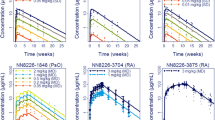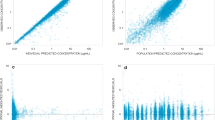Abstract
The objective of this paper is to present a population PK model which adequately describes the time–concentration profiles of different doses of etanercept (Enbrel®) administered subcutaneously to subjects with moderate-to-severe psoriasis and to simulate the time courses of concentrations following 50 mg once weekly (QW) dosing. Pharmacokinetic (PK) data from three clinical studies with doses 25 mg QW, 25 mg twice weekly (BIW) and 50 mg BIW, were used. A one-compartment model with gender, weight and time covariates on the apparent clearance and weight covariate on the apparent volume of distribution was developed. The population mean of the apparent steady state clearance in males was 0.129 l/h, compared to 0.148 l/h in females. The clearance varied with time being lower in the first 2 weeks of the therapy, increasing sharply during weeks 3–4, and converging gradually after that to its steady state level. The population mean of the apparent volume of distribution also varied with time and was 16.1 l during week 1, 20.0 l during weeks 2–4 and 22.5 l after week 4. The population PK model adequately described the observed concentration–time profiles in subjects with psoriasis. Despite a somewhat different covariate set, the parameter estimates of the population PK model for etanercept are very similar between the psoriasis and rheumatoid arthritis populations. The population PK model was used to simulate the pharmacokinetic profiles after a novel 50 mg QW dosing regimen. The simulations show good agreement with the observed data from 84 subjects participating in a fourth study (50 mg QW dose) used as an external validation set. The simulations of the 50 mg QW and the 25 mg BIW dosing regimens show that there is a significant overlap between the profiles yielding similar steady state exposures with both dosing regimens. The latter is an indication that the respective efficacy and safety profiles after those two dosing regimens are likely to be similar.
Similar content being viewed by others
Abbreviations
- ACR20:
-
American College of Rheumatology response criteria of 20% improvement
- AUC:
-
area under the concentration curve
- BIW:
-
twice weekly
- BMI:
-
body mass index
- BSA:
-
body surface area formula=0.007184* (weight in kg)0.425* (height in cm)0.725
- BQL:
-
below quantification limit
- CI:
-
confidence interval
- CL:
-
clearance
- CL/F:
-
apparent clearance
- CRF:
-
case report form
- CSR:
-
clinical study report
- CV:
-
coefficient of variation
- Cmax:
-
maximum concentration
- Cmin:
-
minimum concentration
- df:
-
degrees of freedom
- DOPD:
-
duration of psoriasis disease
- ELISA:
-
enzyme-linked immunosorbent assay
- F:
-
bioavailability
- FDA:
-
food and Drug Administration
- FO:
-
first-order
- FOCE:
-
first-order conditional estimation
- GAM:
-
generalized additive model analysis
- IV:
-
intravenous
- IIV:
-
interindividual variability
- IOV:
-
interoccasion variability
- IV:
-
intravenous
- Ka:
-
absorption rate constant
- LLOQ:
-
lower limit of quantification
- n:
-
number of subjects
- NC:
-
not calculated
- NCA:
-
noncompartmental analysis
- ND:
-
no data
- NSAIDs:
-
nonsteroidal anti-inflammatory drugs
- OFV:
-
objective function value
- OCC:
-
occasion
- PASB:
-
PASI score at baseline
- PASI:
-
psoriasis area and severity index
- PD:
-
pharmacodynamic(s)
- PK:
-
pharmacokinetic(s)
- PSPT:
-
prior systemic or phototherapy
- QOL:
-
quality of life
- QW:
-
once weekly
- RA:
-
rheumatoid arthritis
- SC:
-
subcutaneous
- SD:
-
standard deviation
- TAD:
-
time since last administered dose
- TNF:
-
tumor necrosis factor, cachectin (previously known as TNFα)
- TNFR:
-
tumor necrosis factor receptor
- V:
-
volume of distribution
- V/F:
-
apparent volume of distribution
- WTKG:
-
weight in kilograms
References
J. Koo (1996) ArticleTitlePopulation-based epidemiologic study of psoriasis with emphasis on quality of life assessment Dermatol. Clin 14 485–496 Occurrence Handle8818558
R. D. Granstein (2001) ArticleTitleNew treatments for psoriasis N. Engl. J. Med 345 284–287 Occurrence Handle11474669
C. Bonifati F. Ameglio (1999) ArticleTitleCytokines in psoriasis Int. J. Dermatol 38 241–251 Occurrence Handle10321938
L. W. Moreland M. H. Schiff S. W. Baumgartner E. A. Tindall R. M. Fleischmann K. J. Bulpitt A. L. Weaver E. C. Keystone D. E. Furst P. J. Mease E. M. Ruderman D. A. Horwitz D. G. Arkfeld L. Garrison D. J. Burge C. M. Blosch M. L. M. Lange N. D. McDonnell M. E. Weinblatt (1999) ArticleTitleEtanercept therapy in rheumatoid arthritis: A randomized, controlled trial Ann. Int. Med 130 478–486 Occurrence Handle10075615
M. E. Weinblatt J. M. Kremer A. D. Bankhurst K. J. Bulpitt R. M. Fleischmann R. I. Fox C. G. Jackson M. Lange D. J. Burge (1999) ArticleTitleA trial of etanercept, a recombinant tumor necrosis factor receptor: Fc fusion protein, in patients with rheumatoid arthritis receiving methotrexate N. Engl. J. Med 340 253–259 Occurrence Handle9920948
P. J. Mease B. S. Goffe J. Metz A. VanderStoep B. Finck D. J. Burge (2000) ArticleTitleEtanercept in the treatment of psoriatic arthritis and psoriasis: A randomised trial Lancet 356 385–390 Occurrence Handle10972371
C. L. Leondardi J. L. Powers R. T. Matheson B. S. Goffe R. Zitnik A. Wang A. B. Gottlieb (2003) ArticleTitleEtanercept as a monotherapy in patients with psoriasis N. Engl. J. Med 349 2014–2022 Occurrence Handle14627786
J. M. Korth-Bradley A. S. Rubin R. K. Hanna D. K. Simcoe M. E. Lebsack (2000) ArticleTitleThe pharmacokinetics of etanercept in healthy volunteers Ann. Pharmacother 34 161–164 Occurrence Handle10676822
M. E. Lebsack R. K. Hanna M. A. Lange A. Newman W. Ji J. M. Korth-Bradley (1997) ArticleTitleAbsolute bioavailability of TNF receptor fusion protein following subcutaneous injection in healthy volunteers (abstract) Pharmacotherapy 17 1118–1119
H. Lee H. C. Kimko M. Rogge D. Wang I. Nestorov C. C. Peck (2003) ArticleTitlePopulation pharmacokinetic (PK) and pharmacodynamic (PD) modeling of Etanercept using logistic regression analysis Clin. Pharmacol. Ther 73 348–365 Occurrence Handle12709725
I. Nestorov, R. Zitnik, C. Banfield, T. DeVries, and A. Wang. Pharmacokinetics of subcutaneously administered etanercept in patients with psoriasis. J. Investig. Dermatol, submitted for publication
M. Karlsson N. Jonsson (1998) Xpose 2.0 User’s Manual Uppsala University Uppsala, Sweden,
E. N. Jonsson M. O. Karlsson (1999) ArticleTitleXpose—an S-PLUS based population pharmacokinetic/pharmacodynamic model building aid for NONMEM Comp. Meth. Prog. Biomed 58 51–64
H. Zhou M. Buckwalter J. Boni P. Mayer D. Raible J. Wajdula S. Fatenejad M. Sanda (2003) ArticleTitlePharmacokinetics (PK) of etanercept ankylosing spondylitis (AS) patients: a population-based investigation (abstract) J. Clin. Pharmacol 43 1033
I. Nestorov M. Lebsack T. DeVries D. Burge (2003) ArticleTitlePharmacokinetics of etanercept after once weekly subcutaneous administration of 50 mg doses to rheumatoid arthritis patients. Abstracts of the Annual European Congress of Rheumatology EULAR 2003 Ann. Rheumat. Dis 62 IssueIDSuppl. 1 THU0239
J. Parke N. H. G. Holford B. G. Charles (1999) ArticleTitleA procedure for generating bootstrap samples for the validation of nonlinear mixed-effects population models Comp. Meth. Prog. Biomed 59 19–29
Author information
Authors and Affiliations
Corresponding author
Rights and permissions
About this article
Cite this article
Nestorov, I., Zitnik, R. & Ludden, T. Population Pharmacokinetic Modeling of Subcutaneously Administered Etanercept in Patients with Psoriasis. J Pharmacokinet Pharmacodyn 31, 463–490 (2004). https://doi.org/10.1007/s10928-005-5912-0
Published:
Issue Date:
DOI: https://doi.org/10.1007/s10928-005-5912-0




